Effect of Laser Surface Structuring on Surface Wettability and Tribological Performance of Bulk Metallic Glass
Abstract
1. Introduction
2. Materials and Methods
2.1. Materials
2.2. Laser Surface Structuring
2.3. Surface Characterizations
3. Results
3.1. Surface Morphology
3.2. Surface Chemistry
3.3. Surface Wettability
3.4. Evaluation of Tribological Performance
3.5. Processing Mechanism Analysis
4. Conclusions
Author Contributions
Funding
Institutional Review Board Statement
Informed Consent Statement
Data Availability Statement
Conflicts of Interest
References
- Chen, M. A brief overview of bulk metallic glasses. NPG Asia Mater. 2011, 3, 82–90. [Google Scholar] [CrossRef]
- Kumar, G.; Desai, A.; Schroers, J. Bulk metallic glass: The smaller the better. Adv. Mater. 2011, 23, 461–476. [Google Scholar] [CrossRef]
- Löffler, J.F. Bulk metallic glasses. Intermetallics 2003, 11, 529–540. [Google Scholar] [CrossRef]
- Telford, M. The case for bulk metallic glass. Mater. Today 2004, 7, 36–43. [Google Scholar] [CrossRef]
- Huang, H.; Yan, J. Investigating shear band interaction in metallic glasses by adjacent nanoindentation. Mater. Sci. Eng. A 2017, A704, 375–385. [Google Scholar] [CrossRef]
- Li, H.F.; Zheng, Y.F. Recent advances in bulk metallic glasses for biomedical applications. Acta Biomater. 2016, 36, 1–20. [Google Scholar] [CrossRef]
- Khan, M.M.; Nemati, A.; Rahman, Z.U.; Shah, U.H.; Asgar, H.; Haider, W. Recent Advancements in Bulk Metallic Glasses and Their Applications: A Review. Crit. Rev. Solid State Mater. Sci. 2018, 43, 233–268. [Google Scholar] [CrossRef]
- Hirano, T.; Kato, H.; Matsuo, A.; Kawamura, Y.; Inoue, A. Synthesis and mechanical properties of Zr55Al10Ni5Cu30 bulk glass composites containing ZrC particles formed by the in-situ reaction. Mater. Trans. JIM 2000, 41, 1454–1459. [Google Scholar] [CrossRef][Green Version]
- Kumar, G.; Tang, H.X.; Schroers, J. Nanomoulding with amorphous metals. Nature 2009, 457, 868–872. [Google Scholar] [CrossRef]
- Hu, Z.; Gorumlu, S.; Aksak, B.; Kumar, G. Patterning of metallic glasses using polymer templates. Scr. Mater. 2015, 108, 15–18. [Google Scholar] [CrossRef]
- He, P.; Li, L.; Wang, F.; Dambon, O.; Klocke, F.; Flores, K.M.; Yi, A.Y. Bulk metallic glass mold for high volume fabrication of micro optics. Microsyst. Technol. 2016, 22, 617–623. [Google Scholar] [CrossRef]
- Chen, N.; Frank, R.; Asao, N.; Louzguine-Luzgin, D.V.; Sharma, P.; Wang, J.Q.; Xie, G.Q.; Ishikawa, Y.; Hatakeyama, N.; Lin, Y.C.; et al. Formation and properties of Au-based nanograined metallic glasses. Acta Mater. 2011, 59, 6433–6440. [Google Scholar] [CrossRef]
- Ketov, S.V.; Shi, X.; Xie, G.; Kumashiro, R.; Churyumov, A.Y.; Bazlov, A.I.; Chen, N.; Ishikawa, Y.; Asao, N.; Wu, H.; et al. Nanostructured Zr-Pd metallic glass thin film for biochemical applications. Sci. Rep. 2015, 5, 7799. [Google Scholar] [CrossRef]
- Zhao, M.; Abe, K.; Yamaura, S.; Yamamoto, Y.; Asao, N. Fabrication of Pd−Ni−P Metallic Glass Nanoparticles and Their Application as Highly Durable Catalysts in Methanol Electro-oxidation. Chem. Mater. 2014, 26, 1056–1061. [Google Scholar] [CrossRef]
- Bakkal, M.; Shih, A.J.; Scattergood, R.O.; Liu, C.T. Machining of a Zr-Ti-Al-Cu-Ni metallic glass. Scr. Mater. 2004, 50, 583–588. [Google Scholar] [CrossRef]
- Zhang, X.; Zhang, Y.; Tong, H.; Li, Y.; Chen, X.; Chen, G. Micro-electro-discharge machining of bulk metallic glasses. In Proceedings of the International Symposium on High Density Packaging and Microsystem Integration 2007, HDP’07, Shanghai, China, 26–28 June 2007; pp. 30–33. [Google Scholar]
- Wang, H.; Zhuang, J.; Qi, H.; Yu, J.; Guo, Z.; Ma, Y. Laser-chemical treated superhydrophobic surface as a barrier to marine atmospheric corrosion. Surf. Coat. Technol. 2020, 401, 126255. [Google Scholar] [CrossRef]
- Wang, H.; Zhuang, J.; Yu, J.; Qi, H.; Ma, Y.; Wang, H.; Guo, Z. Fabrication of Anti-Reflective Surface with Superhydrophobicity/High Oleophobicity and Enhanced Mechanical Durability via Nanosecond Laser Surface Texturing. Materials 2020, 13, 5691. [Google Scholar] [CrossRef]
- Kedia, S.; Bonagani, S.K.; Majumdar, A.G.; Kain, V.; Subramanian, M.; Maiti, N.; Nilaya, J.P. Nanosecond laser surface texturing of type 316L stainless steel for contact guidance of bone cells and superior corrosion resistance. Colloid Interface Sci. Commun. 2021, 42, 100419. [Google Scholar] [CrossRef]
- Emelyanenko, K.A.; Sanzharovsky, N.A.; Chulkova, E.V.; Ganne, A.A.; Emelyanenko, A.M.; Boinovich, L.B. Superhydrophobic corrosion resistant coatings for copper via IR nanosecond laser processing. Mater. Res. Express 2018, 5, 115001. [Google Scholar] [CrossRef]
- Huang, J.; Guan, Y.; Ramakrishna, S. Tribological behavior of femtosecond laser-textured leaded brass. Tribol. Int. 2021, 162, 107115. [Google Scholar] [CrossRef]
- Nagle Travessa, D.; Vilas Boas Guedes, G.; Capella de Oliveira, A.; Regina Cardoso, K.; Roche, V.; Moreira Jorge, A. The effect of surface laser texturing on the corrosion performance of the biocompatible β-Ti12Mo6Zr2Fe alloy. Surf. Coat. Technol. 2021, 405, 126628. [Google Scholar] [CrossRef]
- Hu, T.; Hu, L.; Ding, Q. The effect of laser surface texturing on the tribological behavior of Ti-6Al-4V. Proc. Inst. Mech. Eng. Part J J. Eng. Tribol. 2012, 226, 854–863. [Google Scholar] [CrossRef]
- Ahuir-Torres, J.I.; Arenas, M.A.; Perrie, W.; Dearden, G.; de Damborenea, J. Surface texturing of aluminium alloy AA2024-T3 by picosecond laser: Effect on wettability and corrosion properties. Surf. Coat. Technol. 2017, 321, 279–291. [Google Scholar] [CrossRef]
- Hu, T.; Hu, L. The study of tribological properties of laser-textured surface of 2024 aluminium alloy under boundary lubrication. Lubr. Sci. 2012, 24, 84–93. [Google Scholar] [CrossRef]
- Huang, H.; Jun, N.; Jiang, M.; Ryoko, M.; Yan, J. Nanosecond pulsed laser irradiation induced hierarchical micro/nanostructures on Zr-based metallic glass substrate. Mater. Des. 2016, 109, 153–161. [Google Scholar] [CrossRef]
- Jiao, Y.; Brousseau, E.; Han, Q.; Zhu, H.; Bigot, S. Investigations in nanosecond laser micromachining on the Zr52.8Cu17.6Ni14.8Al9.9Ti4.9 bulk metallic glass: Experimental and theoretical study. J. Mater. Process. Technol. 2019, 273, 116232. [Google Scholar] [CrossRef]
- Jiao, Y.; Brousseau, E.; Shen, X.; Wang, X.; Han, Q.; Zhu, H.; Bigot, S.; He, W. Investigations in the fabrication of surface patterns for wettability modification on a Zr-based bulk metallic glass by nanosecond laser surface texturing. J. Mater. Process. Technol. 2020, 283, 116714. [Google Scholar] [CrossRef]
- Jiao, Y.; Brousseau, E.; Nishio Ayre, W.; Gait-Carr, E.; Shen, X.; Wang, X.; Bigot, S.; Zhu, H.; He, W. In vitro cytocompatibility of a Zr-based metallic glass modified by laser surface texturing for potential implant applications. Appl. Surf. Sci. 2021, 547, 149194. [Google Scholar] [CrossRef]
- Du, C.; Wang, C.; Zhang, T.; Yi, X.; Liang, J.; Wang, H. Reduced bacterial adhesion on zirconium-based bulk metallic glasses by femtosecond laser nanostructuring. Proc. Inst. Mech. Eng. Part H J. Eng. Med. 2020, 234, 387–397. [Google Scholar] [CrossRef]
- Sawyer, V.; Tao, X.; Dong, H.; Dashtbozorg, B.; Li, X.; Sammons, R.; Dong, H.S. Improving the tribological properties and biocompatibility of Zr-based bulk metallic glass for potential biomedical applications. Materials 2020, 13, 1960. [Google Scholar] [CrossRef]
- Wu, H.; Baker, I.; Liu, Y.; Wu, X.; Munroe, P.R. Effects of environment on the sliding tribological behaviors of Zr-based bulk metallic glass. Intermetallics 2012, 25, 115–125. [Google Scholar] [CrossRef]
- Wu, H.; Liang, L.; Lan, X.; Yin, Y.; Song, M.; Li, R.; Liu, Y.; Yang, H.; Liu, L.; Cai, A.; et al. Tribological and biological behaviors of laser cladded Ti-based metallic glass composite coatings. Appl. Surf. Sci. 2020, 507, 145104. [Google Scholar] [CrossRef]
- Lan, X.; Wu, H.; Liu, Y.; Zhang, W.; Li, R.; Chen, S.; Zai, X.; Hu, T. Microstructures and tribological properties of laser cladded Ti-based metallic glass composite coatings. Mater. Charact. 2016, 120, 82–89. [Google Scholar] [CrossRef]
- Qian, Y.; Jiang, M.; Zhang, Z.; Huang, H.; Yan, J. On the transformation between micro-concave and micro-convex in nanosecond laser ablation of a Zr-based metallic glass. J. Manuf. Process. 2021, 68, 1114–1122. [Google Scholar] [CrossRef]
- Zhang, H.; Qian, Y.; Zhang, L.; Zhang, D.; Liu, H.; Huang, H. Surface coloration of Zr-based metallic glass by nanosecond pulsed laser irradiation in ambient atmosphere. Mater. Lett. 2021, 304, 130721. [Google Scholar] [CrossRef]
- Li, Z.; Ma, J. Water-repellent surfaces of metallic glasses: Fabrication and application. Mater. Today Adv. 2021, 12, 100164. [Google Scholar] [CrossRef]
- Gregorčič, P.; Šetina-Batič, B.; Hočevar, M.; Šetina-Batič, B.; Hočevar, M.; Šetina-Batič, B.; Hočevar, M. Controlling the stainless steel surface wettability by nanosecond direct laser texturing at high fluences. Appl. Phys. A Mater. Sci. Process. 2017, 123, 766. [Google Scholar] [CrossRef]
- Ngo, C.V.; Chun, D.M. Effect of Heat Treatment Temperature on the Wettability Transition from Hydrophilic to Superhydrophobic on Laser-Ablated Metallic Surfaces. Adv. Eng. Mater. 2018, 20, 1701086. [Google Scholar] [CrossRef]
- Wang, Q.; Wang, H.; Zhu, Z.; Xiang, N.; Wang, Z.; Sun, G. Switchable wettability control of titanium via facile nanosecond laser-based surface texturing. Surf. Interfaces 2021, 24, 101122. [Google Scholar] [CrossRef]
- Borruto, A.; Crivellone, G.; Marani, F. Influence of surface wettability on friction and wear tests. Wear 1998, 222, 57–65. [Google Scholar] [CrossRef]
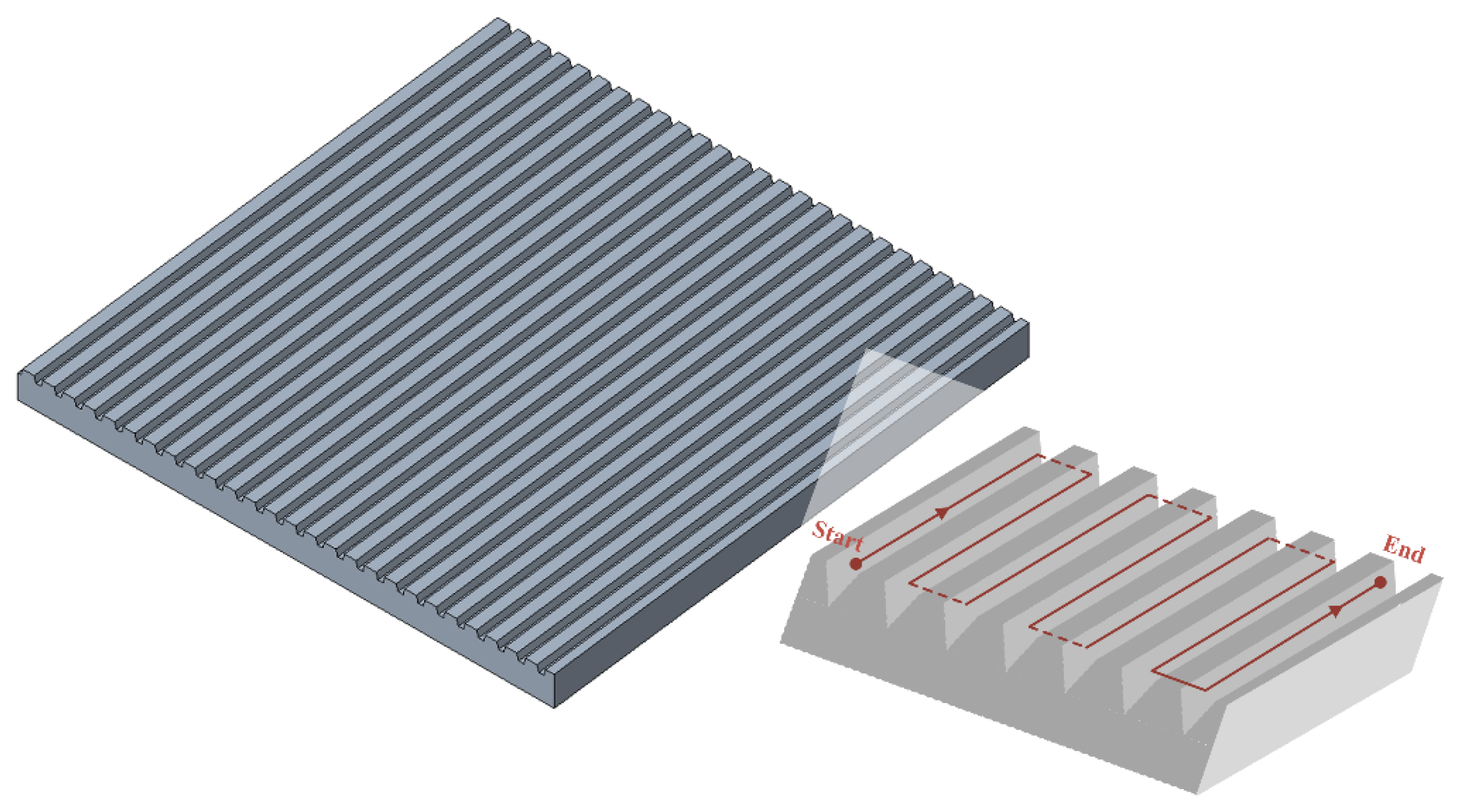

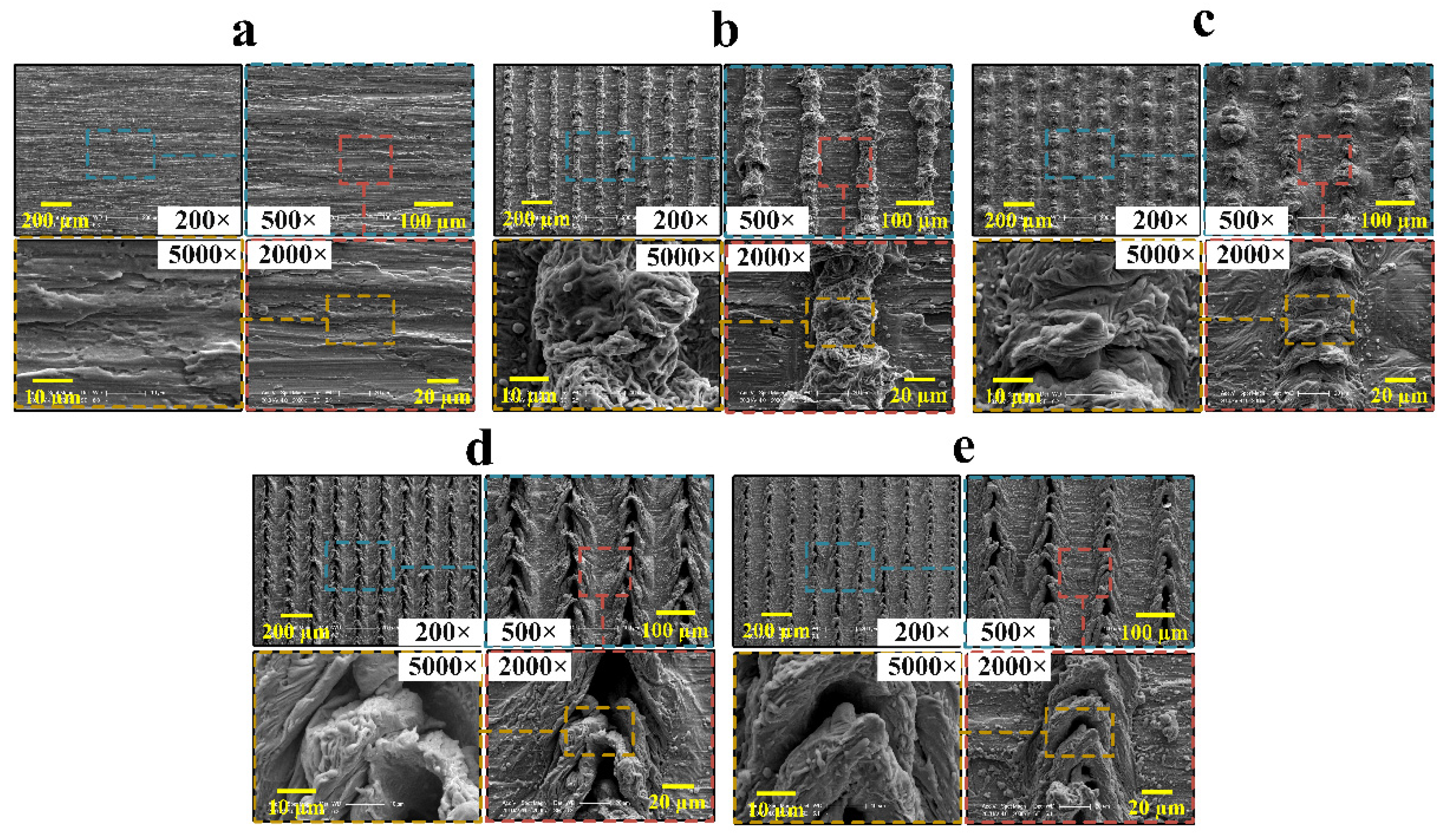
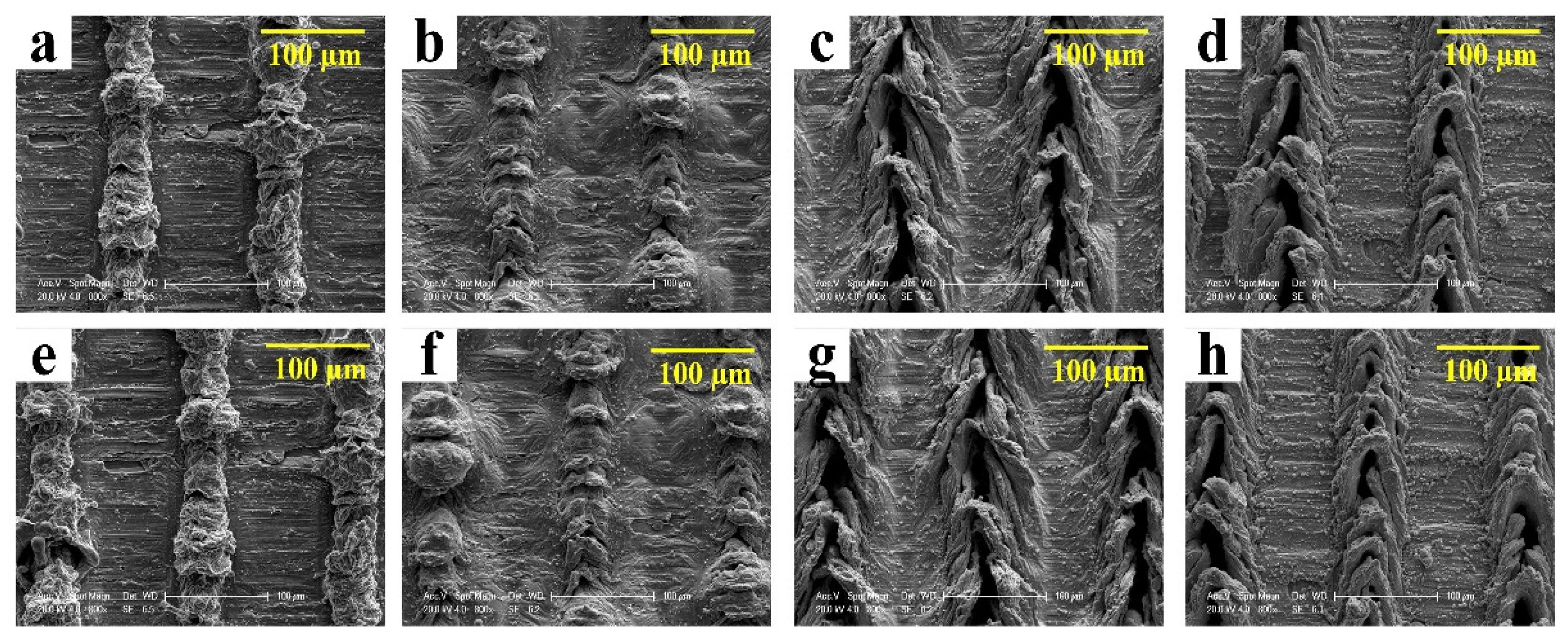
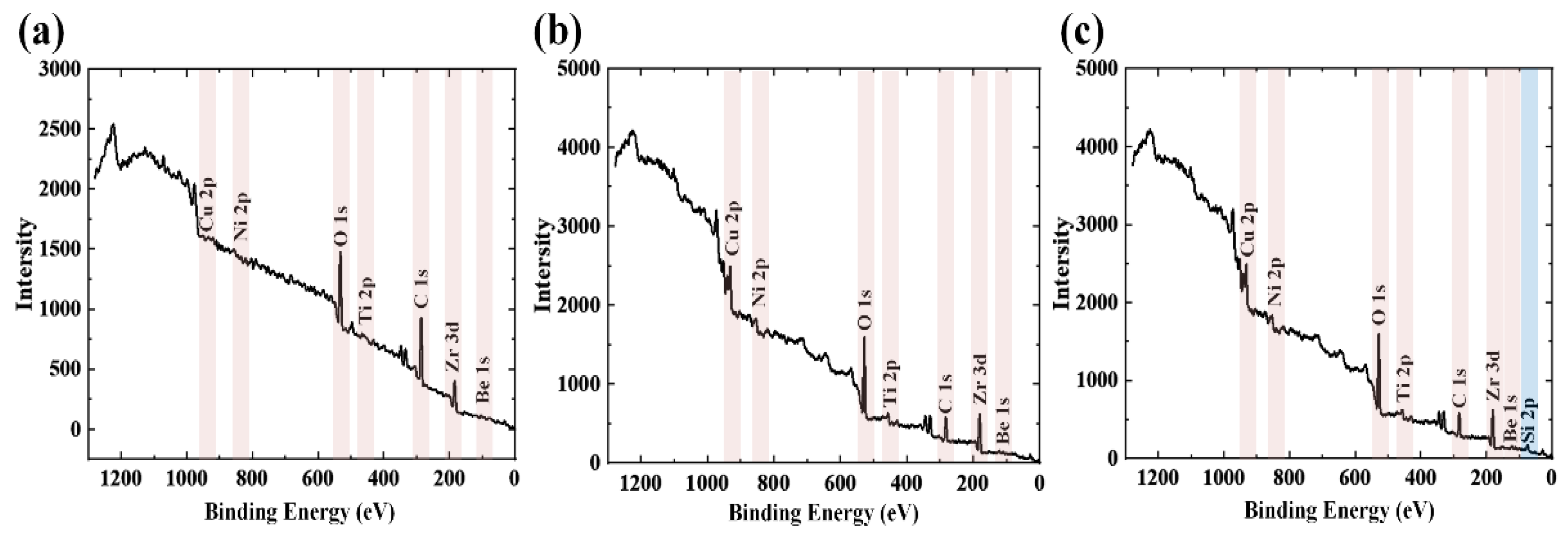
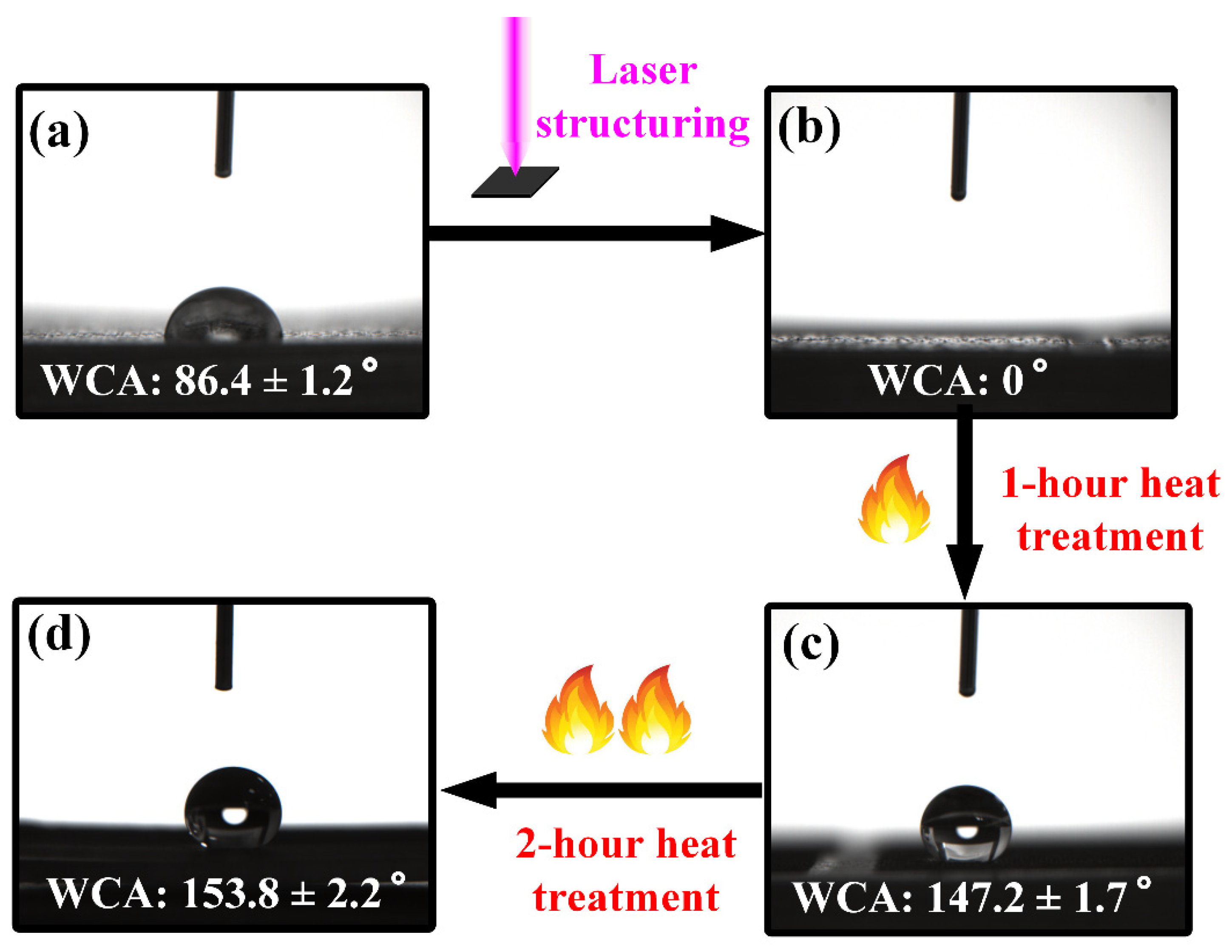


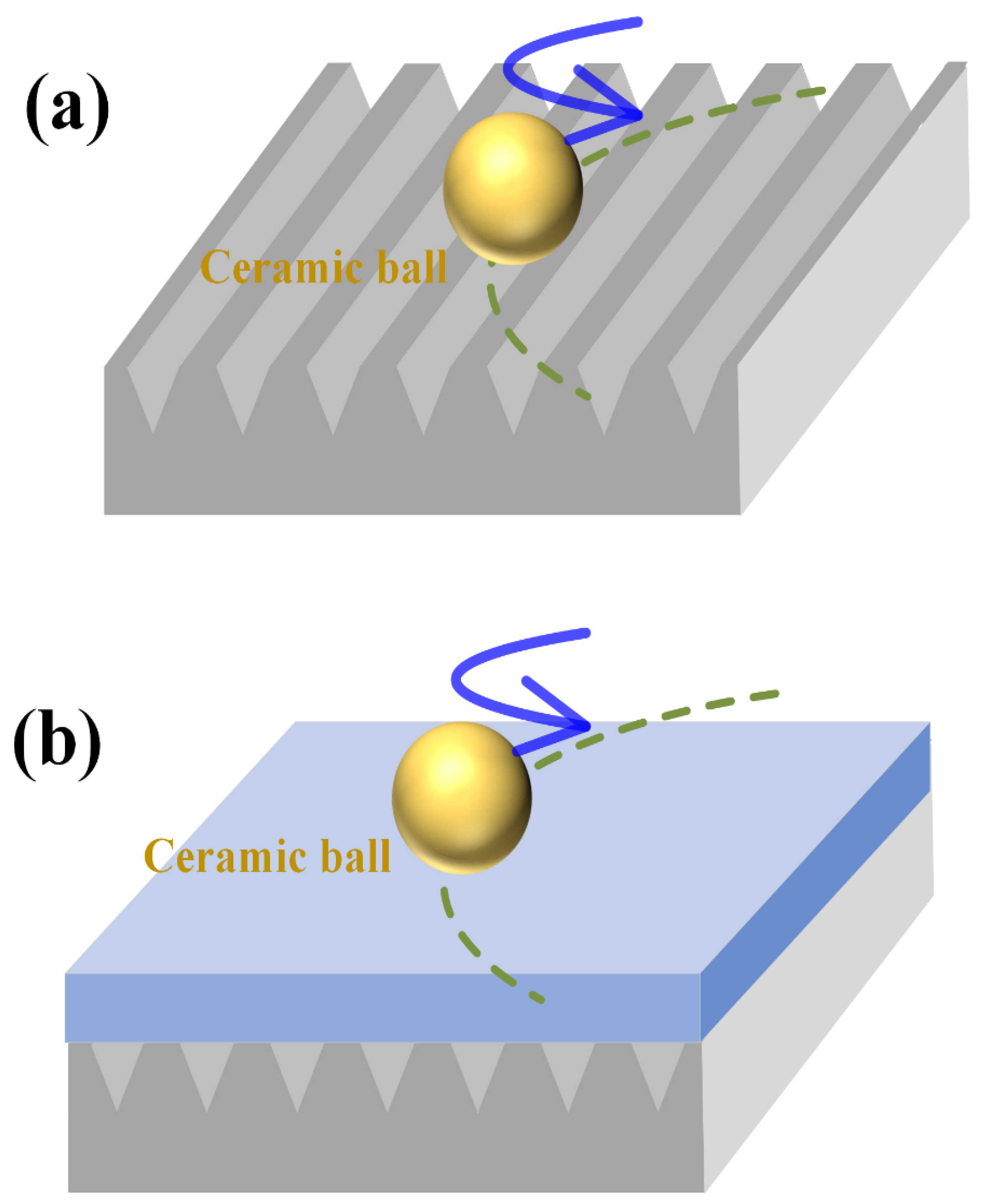
| Name of Parameter | Value |
|---|---|
| Average power (W) | 15.0 |
| Repetition rate (kHz) | 30 |
| Pulse width (ns) | 20 |
| Scanning speed (mm/s) | 20, 40, 60, 80 |
| Step size (µm) | 150 |
| Power intensity (GW/cm2) | 2.60 |
| Pulse energy (mJ) | 0.5 |
| Heat treatment temperature (°C) | 150 |
| Maximum heat treatment duration (hours) | 2 |
| Element (Atomic %) | Untreated | Laser-Structured | Laser-Heat-Treated |
|---|---|---|---|
| C 1s | 62.35 | 30.85 | 37.80 |
| O 1s | 26.88 | 47.85 | 41.51 |
| Be 1s | 8.17 | 8.58 | 8.16 |
| Zr 3d | 2.08 | 3.91 | 4.16 |
| Ti 2p | 0.18 | 2.72 | 1.18 |
| Ni 2p | 0.23 | 1.43 | 1.46 |
| Cu 2p | 0.11 | 4.66 | 3.96 |
| Si 2p | - | - | 1.77 |
| Surface Type | Lubrication Condition | Average COF |
|---|---|---|
| Untreated | Dry | 0.609 |
| Untreated | Water | 0.456 |
| Superhydrophobic + 20 mm/s | Dry | 0.330 |
| Superhydrophobic + 20 mm/s | Water | 0.246 |
| Superhydrophobic + 60 mm/s | Dry | 0.331 |
| Superhydrophobic + 60 mm/s | Water | 0.233 |
Publisher’s Note: MDPI stays neutral with regard to jurisdictional claims in published maps and institutional affiliations. |
© 2022 by the authors. Licensee MDPI, Basel, Switzerland. This article is an open access article distributed under the terms and conditions of the Creative Commons Attribution (CC BY) license (https://creativecommons.org/licenses/by/4.0/).
Share and Cite
Wang, Q.; Zhou, Y.; Wu, P.; Qu, C.; Wang, H. Effect of Laser Surface Structuring on Surface Wettability and Tribological Performance of Bulk Metallic Glass. Crystals 2022, 12, 748. https://doi.org/10.3390/cryst12050748
Wang Q, Zhou Y, Wu P, Qu C, Wang H. Effect of Laser Surface Structuring on Surface Wettability and Tribological Performance of Bulk Metallic Glass. Crystals. 2022; 12(5):748. https://doi.org/10.3390/cryst12050748
Chicago/Turabian StyleWang, Qinghua, Yongqi Zhou, Pengyu Wu, Chengyu Qu, and Huixin Wang. 2022. "Effect of Laser Surface Structuring on Surface Wettability and Tribological Performance of Bulk Metallic Glass" Crystals 12, no. 5: 748. https://doi.org/10.3390/cryst12050748
APA StyleWang, Q., Zhou, Y., Wu, P., Qu, C., & Wang, H. (2022). Effect of Laser Surface Structuring on Surface Wettability and Tribological Performance of Bulk Metallic Glass. Crystals, 12(5), 748. https://doi.org/10.3390/cryst12050748







